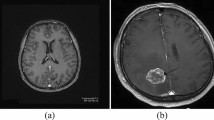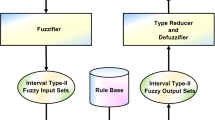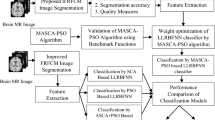Abstract
Background
Investigation of brain cancer can detect the abnormal growth of tissue in the brain using computed tomography (CT) scans and magnetic resonance (MR) images of patients. The proposed method classifies brain cancer on shape-based feature extraction as either benign or malignant. The authors used input variables such as shape distance (SD) and shape similarity measure (SSM) in fuzzy tools, and used fuzzy rules to evaluate the risk status as an output variable. We presented a classifier neural network system (NNS), namely Levenberg–Marquardt (LM), which is a feed-forward back-propagation learning algorithm used to train the NN for the status of brain cancer, if any, and which achieved satisfactory performance with 100% accuracy.
Methods
The proposed methodology is divided into three phases. First, we find the region of interest (ROI) in the brain to detect the tumors using CT and MR images. Second, we extract the shape-based features, like SD and SSM, and grade the brain tumors as benign or malignant with the concept of SD function and SSM as shape-based parameters. Third, we classify the brain cancers using neuro-fuzzy tools. In this experiment, we used a 16-sample database with SSM (μ) values and classified the benignancy or malignancy of the brain tumor lesions using the neuro-fuzzy system (NFS).
Results
We have developed a fuzzy expert system (FES) and NFS for early detection of brain cancer from CT and MR images. In this experiment, shape-based features, such as SD and SSM, were extracted from the ROI of brain tumor lesions. These shape-based features were considered as input variables and, using fuzzy rules, we were able to evaluate brain cancer risk values for each case. We used an NNS with LM, a feed-forward back-propagation learning algorithm, as a classifier for the diagnosis of brain cancer and achieved satisfactory performance with 100% accuracy. The proposed network was trained with MR image datasets of 16 cases. The 16 cases were fed to the ANN with 2 input neurons, one hidden layer of 10 neurons and 2 output neurons. Of the 16-sample database, 10 datasets for training, 3 datasets for validation, and 3 datasets for testing were used in the ANN classification system. From the SSM (µ) confusion matrix, the number of output datasets of true positive, false positive, true negative and false negative was 6, 0, 10, and 0, respectively. The sensitivity, specificity and accuracy were each equal to 100%.
Conclusion
The method of diagnosing brain cancer presented in this study is a successful model to assist doctors in the screening and treatment of brain cancer patients. The presented FES successfully identified the presence of brain cancer in CT and MR images using the extracted shape-based features and the use of NFS for the identification of brain cancer in the early stages. From the analysis and diagnosis of the disease, the doctors can decide the stage of cancer and take the necessary steps for more accurate treatment. Here, we have presented an investigation and comparison study of the shape-based feature extraction method with the use of NFS for classifying brain tumors as showing normal or abnormal patterns. The results have proved that the shape-based features with the use of NFS can achieve a satisfactory performance with 100% accuracy. We intend to extend this methodology for the early detection of cancer in other regions such as the prostate region and human cervix.



















Similar content being viewed by others
References
Kar S, Dutta Majumder D (2016) An investigative study on early diagnosis of breast cancer using a new approach of mathematical shape theory and neuro-fuzzy classification system. Int J Fuzzy Sys 18(3):349–366
Banarjee DK, Parui SK, Majumder DD (1994) A shape metric for 3-D objects. Indian J Pure Appl Math 25(1 and 2):95–111
Majumder DD (1995) A study on a mathematical theory of shapes in relation to pattern recognition and computer vision. Indian J Theor Phys 43(4):19–30
Majumder DD, Bhattacharya M (1998) A new shape based technique for classification and registration: application to multimodal medical images. Int J Image Process Commun 4(3–4):45–70
Majumder DD, Roy P (2000) Cancer self-remission or tumor instability − cybernetic analysis: a fresh paradigm for cancer treatment. Kybernetes 29(7):896–927
Majumder DD, Bhattacharya M (2000) Cybernetic approach to medical technology: application to cancer screening and other diagnostics. Kybernetes 29:871–895
Majumder DD (2015) Physics, chemistry and biology of nano-scale bio-technology-need for a unified framework for nano-architectures, DNA structures and nano-computing. EKHO-MANJARI: A Magazine on Science and Culture, pp.13–32, BKC college, Kolkata
Majumder DD (2016) 21st Century Norbert Wiener Memorial Lecture. Thinking machines in the physical world in the context of twenty first century, IEEE-INDIA, 23rd April, SKYPE SESSION, 13–30 to 14–30 pm
Majumder DD, Bhattacharya M (1997a) A shape based approach to automated screening of malignancy in tumors in tomography and other related images. IETE Conference NASELSOM
Parui SK, Majumder DD (1982) A new definition of shape similarity. Pattern Recogn Lett 1:87–120
Parui SK, Majumder DD (1983) Symmetry analysis by computer. Pattern Recogn 16:63–67
Majumder DD, Bhattacharya M (1998b) A multimodal medical imaging processing system for diagnosis and therapy planning. International Conference on Computers and Devices for Communication, 4–17, January, Calcutta, India (CODEC)
Majumder DD, Bhattacharya M (1998c) A multimodal medical image processing system for therapeutic planning. Silver Jubilee Conference of Society of Management Science and Applied Cybernetics, 12–13 January, SCIMA, vol. 25, pp 45–72
Chaudhuri BB, Majumder DD (1984) Two-tone image processing and recognition. Wiley Eastern Limited, New Delhi, pp 1–63, 88–100
Chanda B, Chaudhuri BB, Majumder DD (1984) Some algorithms for image enhancement incorporating human visual response. Pattern Recogn 17(4):423–428
Parui S, Sarma SE, Majumder DD (1986) How to discriminate shape using shape vector. Pattern Recogn Lett 4:201–204
Majumder DD, Ray KS (1982) A conceptual study on modification of power plant instrumentation and control. Proceedings of the Symposium on Instrumentation: Recent Trends in Research and Development, Inst. Elec. Tel. Engrs., Calcutta, India, June
Leemput KV, Maes F, Vandermeulen D, Suetens P (1999) Automated model-based tissue classification of MR images of the brain. IEEE Trans Med Imaging 18(10):897–908
Hall L, Bensaid A, Clarke L, Velthuizen R, Silbiger M, Bezdek J (1992) A comparison of neural network and fuzzy clustering techniques in segmenting magnetic resonance images of the brain. IEEE Trans Med Imaging 3(5):672–682
Acknowledgements
We acknowledge with thanks the help and cooperation from the Dumkal Institute of Engineering and Technology, Murshidabad, West Bengal, India and Indian Statistical Institute, Kolkata, India.
Author information
Authors and Affiliations
Corresponding author
Ethics declarations
Conflict of interest
The authors declare that they have no conflict of interest.
About this article
Cite this article
Kar, S., Majumder, D.D. A mathematical theory of shape and neuro-fuzzy methodology-based diagnostic analysis: a comparative study on early detection and treatment planning of brain cancer. Int J Clin Oncol 22, 667–681 (2017). https://doi.org/10.1007/s10147-017-1110-5
Received:
Accepted:
Published:
Issue Date:
DOI: https://doi.org/10.1007/s10147-017-1110-5




